|
|
Isfahan's Mosques
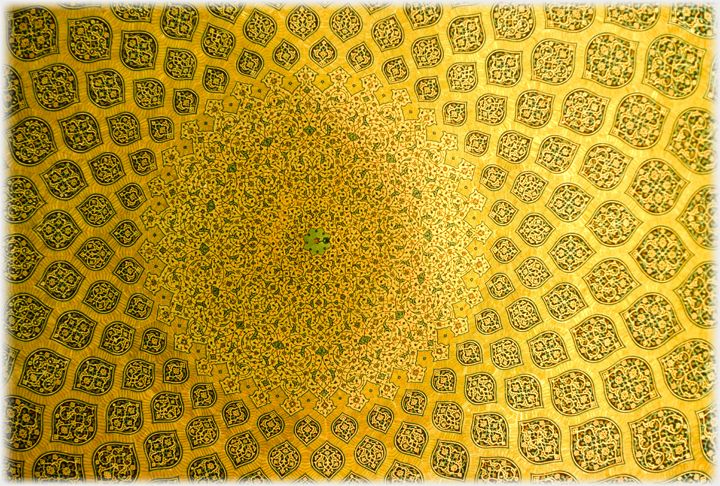 Looking up inside the dome of the Shaikh Lotf-Allah Mosque. To get a sense of the scale, notice the lamp hanging down from the centre of the green medallion. The pattern is designed to imitate the tail of a peacock
The
Mosques of Isfahan
Looking up inside the dome of the Shaikh Lotf-Allah Mosque. To get a sense of the scale, notice the lamp hanging down from the centre of the green medallion. The pattern is designed to imitate the tail of a peacock
The
Mosques of Isfahan
 show the work of Islamic artists and architects in its full glory. Today there are still a score or more mosques, while back in the 1600s one source records there being 162. This page has pictures of four of these, including three of great fame: the Shaikh Lotf-Allah, the Friday, and the Jadid-e Abbasi Mosques. One problem for the visitor is that it is normal for new regimes to rename mosques, some of the alternative names are given on this page.
The Shaikh Lotf-Allah Mosque
Alternative written forms include Shaykh or Sheikh Lutfallah or Lotfollah. This is surely a candidate for the world's most beautiful Mosque. It is also a little unusual for example there are no minarets. The mosque was built for the private use of Shah Abbas and his court, so having no congregation to call to prayer there was no need for minarets. It was completed in 1619 and named after a famous Isfahani imam Shaikh Lutf-Allah who lived on the site and died in 1622.
An aside on transliteration. Confusingly, because of the Arabization of Persian, the province which was called Pars became Fars, and the language called Parsi became Farsi. The Western world preferred to keep the name with its Greek origins and so called the country Persia. However this propagated the kind of mistake some still make by calling the UK England: a part of the country is called England/Pars (Fars) and the language is called English/Parsi (Farsi), but the whole is the UK/Iran.
show the work of Islamic artists and architects in its full glory. Today there are still a score or more mosques, while back in the 1600s one source records there being 162. This page has pictures of four of these, including three of great fame: the Shaikh Lotf-Allah, the Friday, and the Jadid-e Abbasi Mosques. One problem for the visitor is that it is normal for new regimes to rename mosques, some of the alternative names are given on this page.
The Shaikh Lotf-Allah Mosque
Alternative written forms include Shaykh or Sheikh Lutfallah or Lotfollah. This is surely a candidate for the world's most beautiful Mosque. It is also a little unusual for example there are no minarets. The mosque was built for the private use of Shah Abbas and his court, so having no congregation to call to prayer there was no need for minarets. It was completed in 1619 and named after a famous Isfahani imam Shaikh Lutf-Allah who lived on the site and died in 1622.
An aside on transliteration. Confusingly, because of the Arabization of Persian, the province which was called Pars became Fars, and the language called Parsi became Farsi. The Western world preferred to keep the name with its Greek origins and so called the country Persia. However this propagated the kind of mistake some still make by calling the UK England: a part of the country is called England/Pars (Fars) and the language is called English/Parsi (Farsi), but the whole is the UK/Iran.
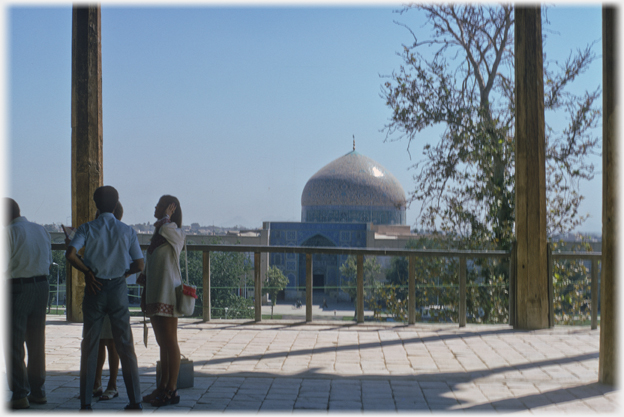 Looking from the roof of the Ali Qapu Palace across Naqsh-e Jahan Square at the dome of the Shaikh Lotf-Allah Mosque
Looking from the roof of the Ali Qapu Palace across Naqsh-e Jahan Square at the dome of the Shaikh Lotf-Allah Mosque
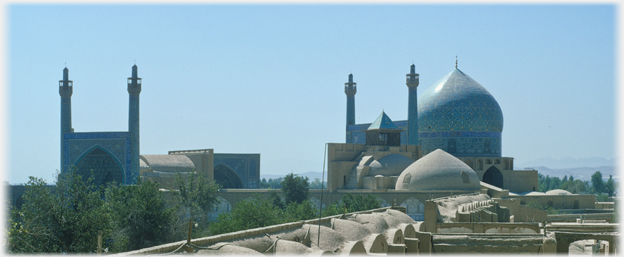 The Jadid-e Abbasi Mosque and the entrance building, seen from the Ali Qapu Palace
The Jadid-e Abbasi Mosque and the entrance building, seen from the Ali Qapu Palace
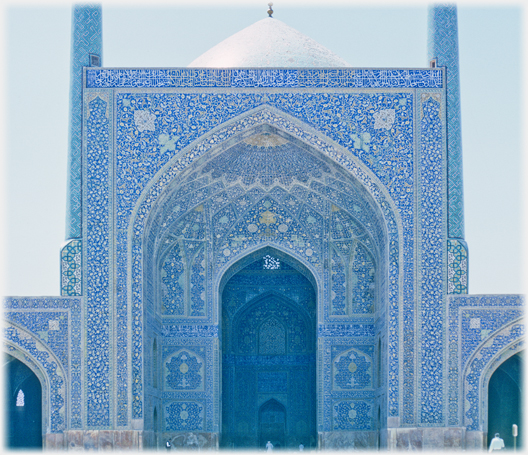 The main iwan of the Jadid-e Abbasi Mosque from the courtyard
The Jadid-e Abbasi Mosque
The New Abbasi Mosque is also known as the Shah Mosque, the Imam Mosque, and the Abbasi Jameh Mosque (Abbasi Congregational Mosque). It is regarded as one of the finest examples of Safavid architecture and it is very large, some 19,000 square metres in extent. Building was begun in 1611 and completed around 1630. It became a second congregational mosque along with the Old Friday Mosque, (see below) hence two of the names applied to it. This was a highly significant political event, attempting to legitimise the new dynasty and to do so without challenging the symbolism of the old mosque. It seems to have been successful in this respect - both building are still functioning as intended.
The main iwan of the Jadid-e Abbasi Mosque from the courtyard
The Jadid-e Abbasi Mosque
The New Abbasi Mosque is also known as the Shah Mosque, the Imam Mosque, and the Abbasi Jameh Mosque (Abbasi Congregational Mosque). It is regarded as one of the finest examples of Safavid architecture and it is very large, some 19,000 square metres in extent. Building was begun in 1611 and completed around 1630. It became a second congregational mosque along with the Old Friday Mosque, (see below) hence two of the names applied to it. This was a highly significant political event, attempting to legitimise the new dynasty and to do so without challenging the symbolism of the old mosque. It seems to have been successful in this respect - both building are still functioning as intended.
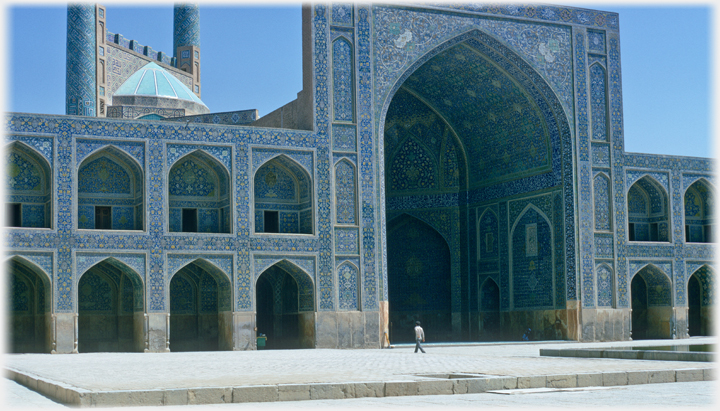 The entrance building of the Jadid-e Abbasi Mosque from the courtyard, which leads out onto Isfahan's main square (Naqsh-i Jahan). As the Mosque needed to be alined to Mecca, and the square is not so alined, the architects gave the entrance this disconcerting kink
The entrance building of the Jadid-e Abbasi Mosque from the courtyard, which leads out onto Isfahan's main square (Naqsh-i Jahan). As the Mosque needed to be alined to Mecca, and the square is not so alined, the architects gave the entrance this disconcerting kink
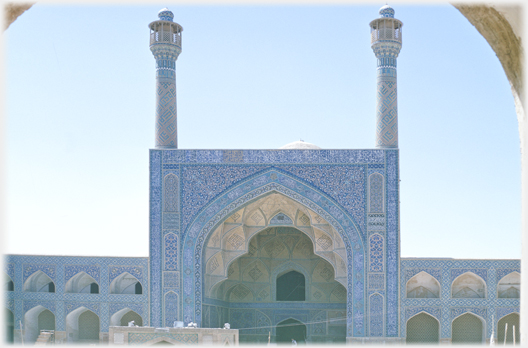 The minarets and main iwan of the Friday Mosque
The Friday Mosque
This mosque sits on the site of a Zoroastrian temple, it became a mosque in the 8th century, and was soon enlarged to include a library, and facilities for a congregation of 5,000. That building was burnt down in 1121. It was rebuilt, and was the main mosque, until the building of the Jadid-e Abbasi Mosque in the 17th century, from which time it has shared the position of the city's principle mosque. Jama, usually rendered as Friday or Congregational in English, can be spelt in a number of ways including: Jama, Jami and Jameh, the principle mosque of a town is given this epithet.
The minarets and main iwan of the Friday Mosque
The Friday Mosque
This mosque sits on the site of a Zoroastrian temple, it became a mosque in the 8th century, and was soon enlarged to include a library, and facilities for a congregation of 5,000. That building was burnt down in 1121. It was rebuilt, and was the main mosque, until the building of the Jadid-e Abbasi Mosque in the 17th century, from which time it has shared the position of the city's principle mosque. Jama, usually rendered as Friday or Congregational in English, can be spelt in a number of ways including: Jama, Jami and Jameh, the principle mosque of a town is given this epithet.
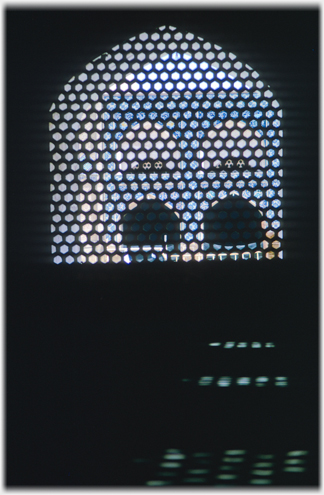 A window in the Friday Mosque
A window in the Friday Mosque
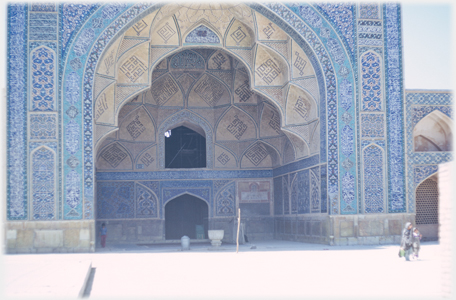 The main iwan of the Friday Mosque
The main iwan of the Friday Mosque
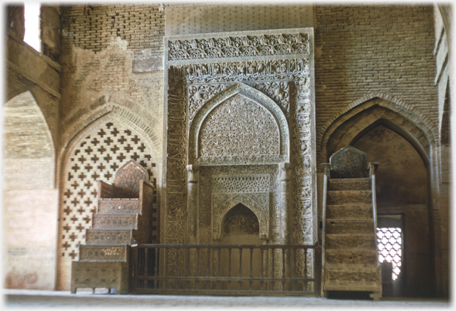 The Mihrab Oljeitu Khodabendeh dates from 1310 and was constructed by the Mongol ruler Oljeitu
The Mihrab Oljeitu Khodabendeh dates from 1310 and was constructed by the Mongol ruler Oljeitu
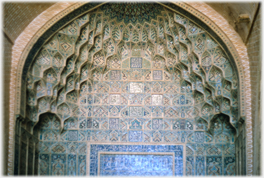 Side Iwan of the Friday Mosque with muqarnas decoration
Side Iwan of the Friday Mosque with muqarnas decoration
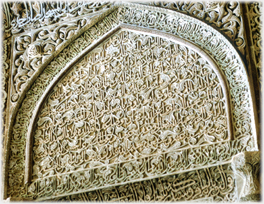 Calligraphy on the Mihrab Oljeitu Khodabendeh
Calligraphy on the Mihrab Oljeitu Khodabendeh
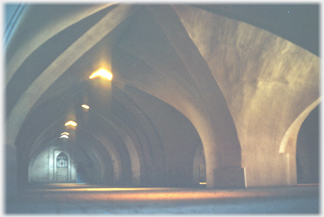 Winter prayer hall below the Friday Mosque
Winter prayer hall below the Friday Mosque
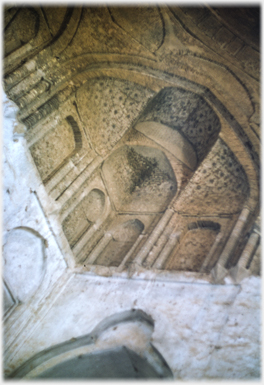 Inside the dome of the Friday Mosque
Inside the dome of the Friday Mosque
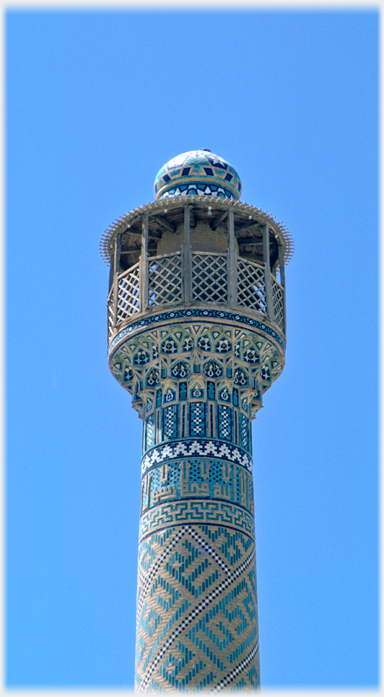 One of the minarets on the Friday Mosque
One of the minarets on the Friday Mosque
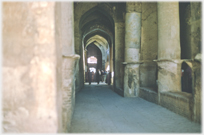 Side corridor of the Friday Mosque
Side corridor of the Friday Mosque
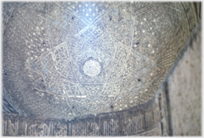 The inside of the northern dome
The inside of the northern dome
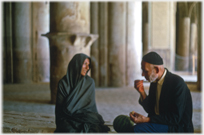 A quiet word in a corner of the mosque
A quiet word in a corner of the mosque
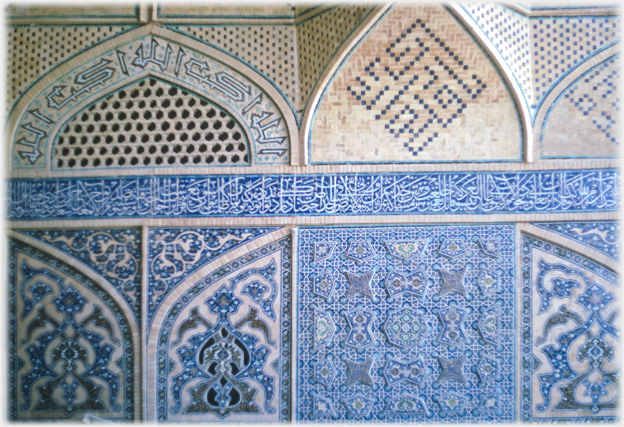 Tile work in the Friday Mosque
Tile work in the Friday Mosque
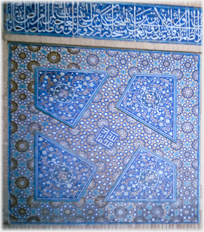 Detail of tile work in the Friday Mosque
Detail of tile work in the Friday Mosque
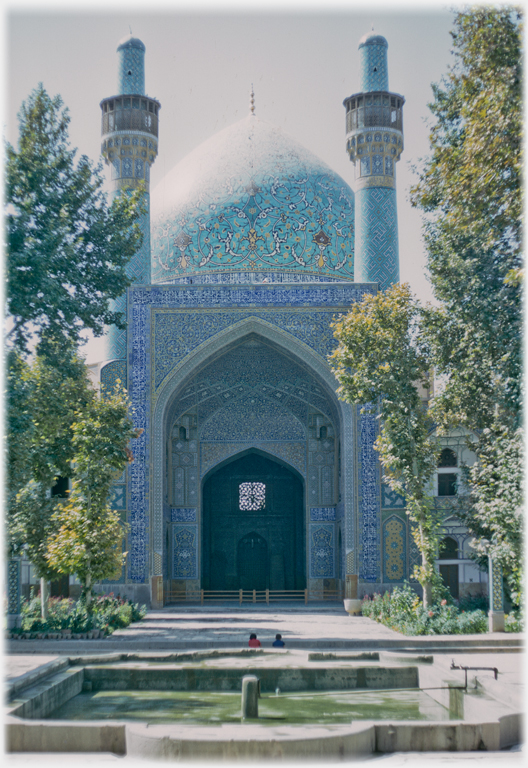 In the grounds of the Sultan Hossain Madrasa with its minarets, dome and one of its garden pools
Sultan Hossain Madrasa
Sometimes called the Chahar Bagh Madrasa, after the road by which it lies, or the Madar-i Shah Madrasa (Mother of the Shah). This mosque is part of a complex which was built at the end of the Safavid period between 1704 and 1710. It, a bazaar and the caravanserai (like a motel for camels) were designed as one complex. The quality of the tile work is superb, a final elegant fling of the dynasty, in contrast to its evident aesthetic decline elsewhere.
In the grounds of the Sultan Hossain Madrasa with its minarets, dome and one of its garden pools
Sultan Hossain Madrasa
Sometimes called the Chahar Bagh Madrasa, after the road by which it lies, or the Madar-i Shah Madrasa (Mother of the Shah). This mosque is part of a complex which was built at the end of the Safavid period between 1704 and 1710. It, a bazaar and the caravanserai (like a motel for camels) were designed as one complex. The quality of the tile work is superb, a final elegant fling of the dynasty, in contrast to its evident aesthetic decline elsewhere.
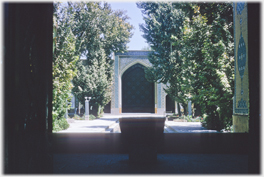 Part of the gardens of the Sultan Hossain Madrasa
Part of the gardens of the Sultan Hossain Madrasa
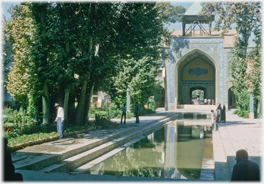 Entrance building of the Sultan Hossain Madrasa
Entrance building of the Sultan Hossain Madrasa
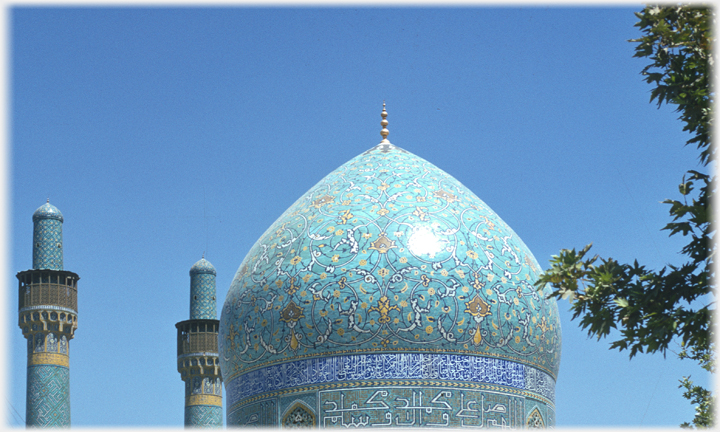 Dome and minarets of the Sultan Hossain Madrasa
The next page
takes you south from Isfahan to the city of Shiraz, famous for the poets Hafez and Saadi, with its pleasant hot dry climate and comfortable ambiance of a provincial university town.
Dome and minarets of the Sultan Hossain Madrasa
The next page
takes you south from Isfahan to the city of Shiraz, famous for the poets Hafez and Saadi, with its pleasant hot dry climate and comfortable ambiance of a provincial university town.
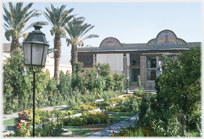

Saturday 25th June 2016

Go to the Picture Posting contents page
Return to the top
|
|
 Looking up inside the dome of the Shaikh Lotf-Allah Mosque. To get a sense of the scale, notice the lamp hanging down from the centre of the green medallion. The pattern is designed to imitate the tail of a peacock
The
Mosques of Isfahan
Looking up inside the dome of the Shaikh Lotf-Allah Mosque. To get a sense of the scale, notice the lamp hanging down from the centre of the green medallion. The pattern is designed to imitate the tail of a peacock
The
Mosques of Isfahan
 show the work of Islamic artists and architects in its full glory. Today there are still a score or more mosques, while back in the 1600s one source records there being 162. This page has pictures of four of these, including three of great fame: the Shaikh Lotf-Allah, the Friday, and the Jadid-e Abbasi Mosques. One problem for the visitor is that it is normal for new regimes to rename mosques, some of the alternative names are given on this page.
The Shaikh Lotf-Allah Mosque
Alternative written forms include Shaykh or Sheikh Lutfallah or Lotfollah. This is surely a candidate for the world's most beautiful Mosque. It is also a little unusual for example there are no minarets. The mosque was built for the private use of Shah Abbas and his court, so having no congregation to call to prayer there was no need for minarets. It was completed in 1619 and named after a famous Isfahani imam Shaikh Lutf-Allah who lived on the site and died in 1622.
An aside on transliteration. Confusingly, because of the Arabization of Persian, the province which was called Pars became Fars, and the language called Parsi became Farsi. The Western world preferred to keep the name with its Greek origins and so called the country Persia. However this propagated the kind of mistake some still make by calling the UK England: a part of the country is called England/Pars (Fars) and the language is called English/Parsi (Farsi), but the whole is the UK/Iran.
show the work of Islamic artists and architects in its full glory. Today there are still a score or more mosques, while back in the 1600s one source records there being 162. This page has pictures of four of these, including three of great fame: the Shaikh Lotf-Allah, the Friday, and the Jadid-e Abbasi Mosques. One problem for the visitor is that it is normal for new regimes to rename mosques, some of the alternative names are given on this page.
The Shaikh Lotf-Allah Mosque
Alternative written forms include Shaykh or Sheikh Lutfallah or Lotfollah. This is surely a candidate for the world's most beautiful Mosque. It is also a little unusual for example there are no minarets. The mosque was built for the private use of Shah Abbas and his court, so having no congregation to call to prayer there was no need for minarets. It was completed in 1619 and named after a famous Isfahani imam Shaikh Lutf-Allah who lived on the site and died in 1622.
An aside on transliteration. Confusingly, because of the Arabization of Persian, the province which was called Pars became Fars, and the language called Parsi became Farsi. The Western world preferred to keep the name with its Greek origins and so called the country Persia. However this propagated the kind of mistake some still make by calling the UK England: a part of the country is called England/Pars (Fars) and the language is called English/Parsi (Farsi), but the whole is the UK/Iran.
 Looking from the roof of the Ali Qapu Palace across Naqsh-e Jahan Square at the dome of the Shaikh Lotf-Allah Mosque
Looking from the roof of the Ali Qapu Palace across Naqsh-e Jahan Square at the dome of the Shaikh Lotf-Allah Mosque
 The Jadid-e Abbasi Mosque and the entrance building, seen from the Ali Qapu Palace
The Jadid-e Abbasi Mosque and the entrance building, seen from the Ali Qapu Palace
 The main iwan of the Jadid-e Abbasi Mosque from the courtyard
The Jadid-e Abbasi Mosque
The New Abbasi Mosque is also known as the Shah Mosque, the Imam Mosque, and the Abbasi Jameh Mosque (Abbasi Congregational Mosque). It is regarded as one of the finest examples of Safavid architecture and it is very large, some 19,000 square metres in extent. Building was begun in 1611 and completed around 1630. It became a second congregational mosque along with the Old Friday Mosque, (see below) hence two of the names applied to it. This was a highly significant political event, attempting to legitimise the new dynasty and to do so without challenging the symbolism of the old mosque. It seems to have been successful in this respect - both building are still functioning as intended.
The main iwan of the Jadid-e Abbasi Mosque from the courtyard
The Jadid-e Abbasi Mosque
The New Abbasi Mosque is also known as the Shah Mosque, the Imam Mosque, and the Abbasi Jameh Mosque (Abbasi Congregational Mosque). It is regarded as one of the finest examples of Safavid architecture and it is very large, some 19,000 square metres in extent. Building was begun in 1611 and completed around 1630. It became a second congregational mosque along with the Old Friday Mosque, (see below) hence two of the names applied to it. This was a highly significant political event, attempting to legitimise the new dynasty and to do so without challenging the symbolism of the old mosque. It seems to have been successful in this respect - both building are still functioning as intended.
 The entrance building of the Jadid-e Abbasi Mosque from the courtyard, which leads out onto Isfahan's main square (Naqsh-i Jahan). As the Mosque needed to be alined to Mecca, and the square is not so alined, the architects gave the entrance this disconcerting kink
The entrance building of the Jadid-e Abbasi Mosque from the courtyard, which leads out onto Isfahan's main square (Naqsh-i Jahan). As the Mosque needed to be alined to Mecca, and the square is not so alined, the architects gave the entrance this disconcerting kink
 The minarets and main iwan of the Friday Mosque
The Friday Mosque
This mosque sits on the site of a Zoroastrian temple, it became a mosque in the 8th century, and was soon enlarged to include a library, and facilities for a congregation of 5,000. That building was burnt down in 1121. It was rebuilt, and was the main mosque, until the building of the Jadid-e Abbasi Mosque in the 17th century, from which time it has shared the position of the city's principle mosque. Jama, usually rendered as Friday or Congregational in English, can be spelt in a number of ways including: Jama, Jami and Jameh, the principle mosque of a town is given this epithet.
The minarets and main iwan of the Friday Mosque
The Friday Mosque
This mosque sits on the site of a Zoroastrian temple, it became a mosque in the 8th century, and was soon enlarged to include a library, and facilities for a congregation of 5,000. That building was burnt down in 1121. It was rebuilt, and was the main mosque, until the building of the Jadid-e Abbasi Mosque in the 17th century, from which time it has shared the position of the city's principle mosque. Jama, usually rendered as Friday or Congregational in English, can be spelt in a number of ways including: Jama, Jami and Jameh, the principle mosque of a town is given this epithet.
 A window in the Friday Mosque
A window in the Friday Mosque
 The main iwan of the Friday Mosque
The main iwan of the Friday Mosque
 The Mihrab Oljeitu Khodabendeh dates from 1310 and was constructed by the Mongol ruler Oljeitu
The Mihrab Oljeitu Khodabendeh dates from 1310 and was constructed by the Mongol ruler Oljeitu
 Side Iwan of the Friday Mosque with muqarnas decoration
Side Iwan of the Friday Mosque with muqarnas decoration
 Calligraphy on the Mihrab Oljeitu Khodabendeh
Calligraphy on the Mihrab Oljeitu Khodabendeh
 Winter prayer hall below the Friday Mosque
Winter prayer hall below the Friday Mosque
 Inside the dome of the Friday Mosque
Inside the dome of the Friday Mosque
 One of the minarets on the Friday Mosque
One of the minarets on the Friday Mosque
 Side corridor of the Friday Mosque
Side corridor of the Friday Mosque
 The inside of the northern dome
The inside of the northern dome
 A quiet word in a corner of the mosque
A quiet word in a corner of the mosque
 Tile work in the Friday Mosque
Tile work in the Friday Mosque
 Detail of tile work in the Friday Mosque
Detail of tile work in the Friday Mosque
 In the grounds of the Sultan Hossain Madrasa with its minarets, dome and one of its garden pools
Sultan Hossain Madrasa
Sometimes called the Chahar Bagh Madrasa, after the road by which it lies, or the Madar-i Shah Madrasa (Mother of the Shah). This mosque is part of a complex which was built at the end of the Safavid period between 1704 and 1710. It, a bazaar and the caravanserai (like a motel for camels) were designed as one complex. The quality of the tile work is superb, a final elegant fling of the dynasty, in contrast to its evident aesthetic decline elsewhere.
In the grounds of the Sultan Hossain Madrasa with its minarets, dome and one of its garden pools
Sultan Hossain Madrasa
Sometimes called the Chahar Bagh Madrasa, after the road by which it lies, or the Madar-i Shah Madrasa (Mother of the Shah). This mosque is part of a complex which was built at the end of the Safavid period between 1704 and 1710. It, a bazaar and the caravanserai (like a motel for camels) were designed as one complex. The quality of the tile work is superb, a final elegant fling of the dynasty, in contrast to its evident aesthetic decline elsewhere.
 Part of the gardens of the Sultan Hossain Madrasa
Part of the gardens of the Sultan Hossain Madrasa
 Entrance building of the Sultan Hossain Madrasa
Entrance building of the Sultan Hossain Madrasa
 Dome and minarets of the Sultan Hossain Madrasa
The next page
takes you south from Isfahan to the city of Shiraz, famous for the poets Hafez and Saadi, with its pleasant hot dry climate and comfortable ambiance of a provincial university town.
Dome and minarets of the Sultan Hossain Madrasa
The next page
takes you south from Isfahan to the city of Shiraz, famous for the poets Hafez and Saadi, with its pleasant hot dry climate and comfortable ambiance of a provincial university town.


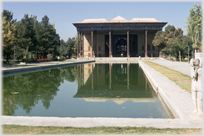 The last page had more pictures of the City of Isfahan
The last page had more pictures of the City of Isfahan
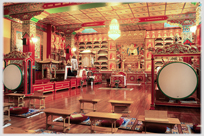 To a Buddhist Temple in southern Scotland - Samye Ling
To a Buddhist Temple in southern Scotland - Samye Ling
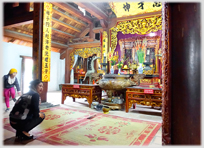 To the Đền Cờn Temple in Vietnam
To the Đền Cờn Temple in Vietnam
